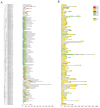Genome-wide identification of R2R3-MYB transcription factor subfamily genes involved in salt stress in rice (Oryza sativa L.)
- PMID: 39179980
- PMCID: PMC11342600
- DOI: 10.1186/s12864-024-10693-5
Genome-wide identification of R2R3-MYB transcription factor subfamily genes involved in salt stress in rice (Oryza sativa L.)
Abstract
Background: R2R3-MYB transcription factors belong to one of the largest gene subfamilies in plants, and they are involved in diverse biological processes. However, the role of R2R3-MYB transcription factor subfamily genes in the response of rice (Oryza sativa L.) to salt stress has been rarely reported.
Results: In this study, we performed a genome-wide characterization and expression identification of rice R2R3-MYB transcription factor subfamily genes. We identified a total of 117 R2R3-MYB genes in rice and characterized their gene structure, chromosomal location, and cis-regulatory elements. According to the phylogenetic relationships and amino acid sequence homologies, the R2R3-MYB genes were divided into four groups. qRT-PCR of the R2R3-MYB genes showed that the expression levels of 10 genes significantly increased after 3 days of 0.8% NaCl treatment. We selected a high expression gene OsMYB2-115 for further analysis. OsMYB2-115 was highly expressed in the roots, stem, leaf, and leaf sheath. OsMYB2-115 was found to be localized in the nucleus, and the yeast hybrid assay showed that OsMYB2-115 has transcriptional activation activity.
Conclusion: This result provides important information for the functional analyses of rice R2R3-MYB transcription factor subfamily genes related to the salt stress response and reveals that OsMYB2-115 may be an important gene associated with salt tolerance in rice.
Keywords: Gene expression; R2R3-MYB; Rice (Oryza sativa L.); Salt stress; Transcription factor.
© 2024. The Author(s).
Conflict of interest statement
The authors declare no competing interests.
Figures






Similar articles
-
A R2R3-type MYB gene, OsMYB2, is involved in salt, cold, and dehydration tolerance in rice.J Exp Bot. 2012 Apr;63(7):2541-56. doi: 10.1093/jxb/err431. Epub 2012 Feb 2. J Exp Bot. 2012. PMID: 22301384 Free PMC article.
-
Genome-wide identification of R2R3-MYB transcription factors in Betula platyphylla and functional analysis of BpMYB95 in salt tolerance.Int J Biol Macromol. 2024 Nov;279(Pt 2):135193. doi: 10.1016/j.ijbiomac.2024.135193. Epub 2024 Aug 30. Int J Biol Macromol. 2024. PMID: 39216584
-
Transcriptome-wide identification of R2R3-MYB transcription factors in barley with their boron responsive expression analysis.Mol Genet Genomics. 2013 Apr;288(3-4):141-55. doi: 10.1007/s00438-013-0740-1. Epub 2013 Mar 29. Mol Genet Genomics. 2013. PMID: 23539153
-
Characterization and expression profiling of MYB transcription factors against stresses and during male organ development in Chinese cabbage (Brassica rapa ssp. pekinensis).Plant Physiol Biochem. 2016 Jul;104:200-15. doi: 10.1016/j.plaphy.2016.03.021. Epub 2016 Mar 18. Plant Physiol Biochem. 2016. PMID: 27038155
-
[Identification and expression analysis of members of R2R3-MYB transcription factors family in Artemisia argyi].Zhongguo Zhong Yao Za Zhi. 2024 Aug;49(16):4407-4419. doi: 10.19540/j.cnki.cjcmm.20240415.103. Zhongguo Zhong Yao Za Zhi. 2024. PMID: 39307777 Chinese.
Cited by
-
Genome-wide identification and functional analysis of R2R3-MYB genes in Acer pseudosieboldianum: insights into low temperature stress response and anthocyanin biosynthesis.BMC Plant Biol. 2025 Jul 2;25(1):795. doi: 10.1186/s12870-025-06782-6. BMC Plant Biol. 2025. PMID: 40596834 Free PMC article.
-
A Series of Novel Alleles of Ehd2 Modulating Heading and Salt Tolerance in Rice.Plants (Basel). 2025 Jan 20;14(2):297. doi: 10.3390/plants14020297. Plants (Basel). 2025. PMID: 39861650 Free PMC article.
-
Identification and Expression Analysis of Rice MYB Family Members in Response to Heat Stress.Plants (Basel). 2025 Jun 11;14(12):1784. doi: 10.3390/plants14121784. Plants (Basel). 2025. PMID: 40573772 Free PMC article.
-
Genome-Wide Analysis of GmMYB S20 Transcription Factors Reveals Their Critical Role in Soybean Nodulation.Plants (Basel). 2025 Jul 20;14(14):2240. doi: 10.3390/plants14142240. Plants (Basel). 2025. PMID: 40733477 Free PMC article.
-
Genome-wide association study identifies elite alleles of FLA2 and FLA9 controlling flag leaf angle in rice.BMC Genomics. 2025 Mar 21;26(1):280. doi: 10.1186/s12864-025-11487-z. BMC Genomics. 2025. PMID: 40119348 Free PMC article.
References
MeSH terms
Substances
Grants and funding
- PL202403/Open funds of the Jiangsu Key Laboratory of Crop Genomics and Molecular Breeding
- BE2022336 and JBGS[2021]001/Jiangsu Province Government
- BM2022008-02/Project of Zhongshan Biological Breeding Laboratory
- B21HJ0220/Hainan Yazhou Bay Seed Lab
- 22KJA210003/Natural Science Foundation of the Jiangsu Higher Education Institutions of China
LinkOut - more resources
Full Text Sources

